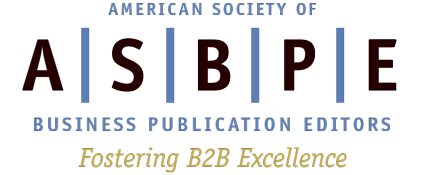
Ever wonder why a newsletter fell flat? What makes a good subject line? And how can a newsletter benefit the reader, the advertiser and the publication?
In an ASBPE webinar May 18—part of the monthlong ASBPE national conference—learn tips and tricks from Scott Costa, publisher of tED magazine and its 2020 Azbee Award-winning newsletter, and Nicky Herron, tED online editor.
The bold newsletter strategy at tED is based on a strong knowledge of the publication’s audience, hinging on two key reasons, Costa says.
Firstly, the tED audience is busy, and the newsletters have to break through the noise; secondly, the audience is smart and wants easy-to-find and relevant news. To keep newsletter open rates consistently above 50%, continuous improvement and evolution was necessary, along with a dedication to relevant and engaging content.
Here, Costa shares some of his recommendations and lessons learned from developing and deploying e-newsletters that continue to make readers stop, open, click, read and learn.
ASBPE: How do you develop strong newsletter content versus content for any other medium?
Costa: I should start by saying that content wins the day, every day. If you do not have relevant, timely, essential news to share, you are going to struggle with your e-newsletters.
Getting that content is not a “wave a magic wand” situation where one piece of advice will lead to strong, relevant content on a daily basis. When [tED Online Editor] Nicky Herron and I teamed up to move from two to six e-newsletters a week, we knew we needed the daily content. It was a difficult effort, contacting as many people as possible, letting them know we needed their news and information, asking them to send us their press releases, and keeping an eye on industry trends that needed to be reported right away. We went from an extremely weak website and two e-newsletters a week to a solid source for news, information, and analysis and newsletters that convey that information to our members.
It took us nearly two years to create the incredibly strong pipeline of content.
ASBPE: How are you tailoring your content to grab attention and clicks?
Costa: For a number of years, it was about the analysis. We would look at the news, and then decide which stories needed a deeper dive to give our readers content they couldn’t find anywhere else. These were our story ideas, written by our journalists, and you could only read those stories on our website. We called those stories “Exclusive Features,” and we put them on every e-newsletter. If you wanted that analysis, you couldn’t find it in our magazine, or anyone else’s magazine—you could only find it through our e-newsletters. We made that extremely clear.
When the pandemic took hold, we found that most readers really just wanted and needed today’s news right away. They didn’t want to wait until tomorrow to find out about major decisions by their state or federal government, new outbreaks, ways to keep people safe, loan opportunities or current economic predictions. We created e-newsletters that delivered as much news as possible and worked to be the go-to source for a wide variety of news that impacted our readers the most.
We used our analytics on a regular basis to see which stories people read the most, and then focused our future e-newsletters on those stories. Their demand dictated our e-newsletter make-up.
But I will add this: if your e-newsletter’s format is predetermined and you are slipping your news content into that format, I think you are doing it wrong. The news should dictate what your e-newsletter looks like, every day.
When two of the three largest electrical distributors in North America merged 17 months ago, that story didn’t look like every other story on our e-newsletters. It looked special compared to everything else because it was a big deal. Recognizing that, and how that story needed to be treated with our readers in mind, created a successful situation. If we made it look like every other story on our e-newsletters, we would look like we didn’t recognize what I call the “hugeness” of that particular story.
Every day, a tED magazine e-newsletter has “Today’s Biggest News.” You can have some fun with that definition, since it might not seem like a bigger news story than the day before. But for that day, it’s the biggest event happening, and we highlight it on our e-newsletters. It definitely grabs the attention of our readers.
ASBPE: Are there any good practices you recommend around headlines or subject lines that drive online interest?
Costa: People and businesses who actively do things usually lead to strong subject lines. Using words like “acquires,” “accuses,” “dies,” “splits,” or “expands” grabs the attention inside email inboxes that are usually pretty cluttered. We have to accept that many times negative news leads to a lot of open e-newsletters. Popular people or businesses could lead to many more. We pick out those selling points very carefully when we create our headlines for stories and subject lines for e-newsletters.
Want to learn more about how tED drives value, clicks and advertiser interest through their newsletter? Check out the webinar next month. Learn more and register here: 2021 ASBPE Conference Weekly Topic Webinars – American Society of Business Publication Editors
